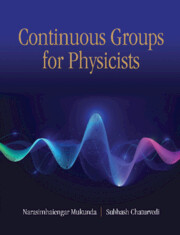Book contents
- Frontmatter
- Dedication
- Epigraph
- Contents
- Preface
- List of Abbreviations
- 1 Basic Group Theory and Representation Theory
- 2 The Symmetric Group
- 3 Rotations in 2 and 3 Dimensions, SU(2)
- 4 General Theory of Lie Groups and Lie Algebras
- 5 Compact Simple Lie Algebras – Classification and Irreducible Representations
- 6 Spinor Representations of the Orthogonal Groups
- 7 Properties of Some Reducible Group Representations, and Systems of Generalised Coherent States
- 8 Structure and Some Properties and Applications of the Groups Sp(2n,ℝ)
- 9 Wigner’s Theorem, Ray Representations and Neutral Elements
- 10 Groups Related to Spacetime
- Index
2 - The Symmetric Group
Published online by Cambridge University Press: 24 November 2022
- Frontmatter
- Dedication
- Epigraph
- Contents
- Preface
- List of Abbreviations
- 1 Basic Group Theory and Representation Theory
- 2 The Symmetric Group
- 3 Rotations in 2 and 3 Dimensions, SU(2)
- 4 General Theory of Lie Groups and Lie Algebras
- 5 Compact Simple Lie Algebras – Classification and Irreducible Representations
- 6 Spinor Representations of the Orthogonal Groups
- 7 Properties of Some Reducible Group Representations, and Systems of Generalised Coherent States
- 8 Structure and Some Properties and Applications of the Groups Sp(2n,ℝ)
- 9 Wigner’s Theorem, Ray Representations and Neutral Elements
- 10 Groups Related to Spacetime
- Index
Summary
In Chapter 1 symmetric group Sn ; the group of permutations of n objects, was introduced as an example of a finite group. An interesting feature of the symmetric group is that every finite group of order n is isomorphic to some subgroup of Sn . This group plays an important role in very many branches of physics and mathematics and has been investigated in great detail right from the early days of group theory. Here we confine ourselves to discussing some known facts and results concerning Sn mainly to illustrate the concepts introduced in Chapter 1. The proofs are quite intricate, and involve ingenious algebraic arguments which could occupy a whole volume. Even to see these results described can be illuminating.
Cycle Structure Notation
In Chapter 1 we learnt two useful notations for an element p ∈ Sn :
While the first form is convenient for stating the composition rule for Sn , the rule for computing inverses and such, as in (1.4), the second, referred to as the cycle structure notation, proves to be extremely useful in delivering a great deal of information about the symmetric group as we shall see. To go from the first form to the second, start from 1 and list the sequence of numbers it visits under repeated applications of p until one is back to the starting point, namely 1. This yields the cycle of 1. Next pick a number j from 1, 2, · · · , n which has not already appeared in the first cycle and construct its cycle. Then pick a number which has not appeared in the first two cycles and so on. Repeat this process until all numbers are exhausted. Thus, for instance, the element
of S6 reads, in the second form, as
Conversely one can go from the second form to the first by viewing (ijk · · · l ) as a set of replacements: i → j , j → k , · · · , l → i.
Information
- Type
- Chapter
- Information
- Continuous Groups for Physicists , pp. 27 - 52Publisher: Cambridge University PressPrint publication year: 2023
